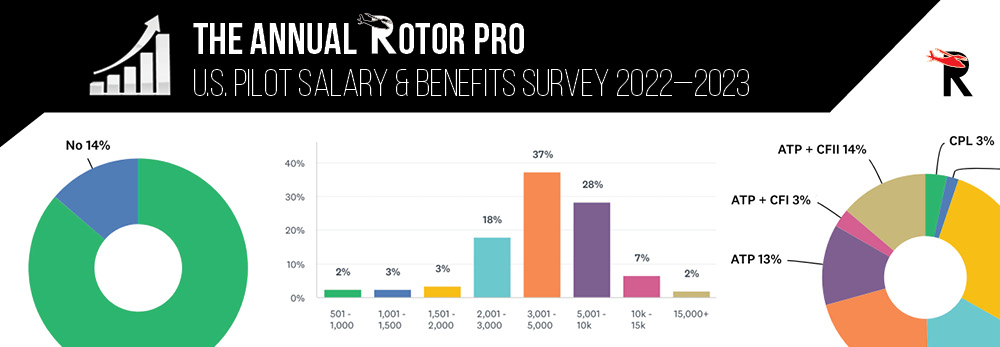|
May
01
2023
|
|
Posted 2 years 242 days ago ago by Admin
|
|

Unfortunately for the industry, the recurring theme is that there are still many external forces impacting the supply of working helicopter pilots. These forces are not only keeping the supply lines short of personnel, but stifling the growth of the base pilot pool as well.
As previously published in the 2021-2022 Salary Survey Report, the forces creating havoc for industry operators stem from many factors to include; aging pilots retiring en-mass, aggressive airline recruitment of helicopter pilots, and the retraction of pilot training pipelines from traditional sources like civilian academies and the U.S. Military. But don’t just take it from us, operators from every sector are feeling the pinch.Tony Bonham, VP of Aviation for Air Evac Lifeteam, one of the largest operators in the U.S., reflected on the situation, "Due to pilot shortages, helicopter air ambulance operators in general are struggling to fill positions at bases all over the U.S. It has become critical in some areas to the degree that some bases are being run part-time. Not only is this not good for business, but it provides less service to the communities we serve.”
Attrition is the word of the day. Many operators are struggling to replace pilots as quickly as they are retiring or moving to opportunities outside of the industry. This ongoing challenge has forced operators to get creative in attracting and retaining personnel. "At Air Evac Lifeteam, we have gone to great lengths to attract pilots to our programs with competitive pay incentives, as well as attractive benefits packages. Retention is also critical for us as we cannot afford to lose any of our high-quality personnel," said Bonham.
The issue has also garnered attention from the Helicopter Association International (HAI). “Analysts predict this trend will last at least a decade. We no longer receive an overflow of resumes when hiring, and other industries are already working together to attract the same people we’d like in our industry. Our industry sectors therefore must work together to solve this issue. We must come together now to find new sources of potential employees to keep the vertical aviation industry working for the public good,” said Jim Viola, President of HAI.
HAI’s Board of Directors recognizes that a shortage of pilots and trained maintenance personnel is a significant issue for the industry. Knowing that the solution will require more than adjusting salaries and benefits, the board created the Workforce Development Working Group to assess all factors and develop strategies to solve the problem. “The HAI working groups are made up of industry experts who are experiencing the same issues and are willing to share their successful solutions. We need to expand our vision to locate new pools of talent and develop pipelines to help these new employees develop the skills they need to enhance their careers and support vertical aviation,” said Greg Brown, the Workforce Development Group’s Lead.
As most are aware, salaries are directly impacted by the size of the labor force. Typically in a shrinking pool of available pilots, salaries and benefits will rise across the board. This has been the case for the last several years according to the data.
In short, with the traditional training pipelines (military and civil) producing less helicopter pilots, combined with more working helicopter pilots leaving the industry all together, HR professionals, recruiters, and helicopter operators industry wide are attempting to work together on how to solve the issue.
READ FULL ARTICLE
READ MORE ROTOR PRO: https://justhelicopters.com/Magazine
WATCH ROTOR PRO YOUTUBE CHANNEL: https://buff.ly/3Md0T3y
You can also find us on
Instagram - https://www.instagram.com/rotorpro1
Facebook - https://www.facebook.com/rotorpro1
Twitter - https://twitter.com/justhelicopters
LinkedIn - https://www.linkedin.com/company/rotorpro1